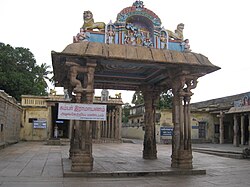Type a search term to find related articles by LIMS subject matter experts gathered from the most trusted and dynamic collaboration tools in the laboratory informatics industry.
| Part of a series on |
| Hindu scriptures and texts |
|---|
 |
| Related Hindu texts |


The Ramavataram, popularly referred to as Kamba Ramayanam, is a Tamil epic that was written by the Tamil poet Kambar during the 12th century. Based on Valmiki's Ramayana (which is in Sanskrit), the story describes the legend of King Rama of Ayodhya. However, the Ramavataram is different from the Sanskrit version in many aspects – both in spiritual concepts and in the specifics of the storyline.[1][2] This historic work is considered by both Tamil scholars and the general public as one of the greatest literary works in Tamil literature.[3]
Kambar wrote this epic with the patronage of Thiruvennai Nallur Sadayappa Vallal, a chieftain of the Pannai lineage.[4] In gratitude to his patron, Kamban references his name once in every 1,000 verses.
Even before Kambar wrote the Ramavataram in Tamil in the 12 century CE, there are many ancient references to the story of Ramayana, implying that the story was familiar in the Tamil lands even before the Common Era. References to the story can be found in the Sangam literature of Akanaṉūṟu,(dated 200 BCE–300 CE)[5] and Purananuru (dated 200 BCE–300 CE),[6][7] the twin epics of Silappatikaram (dated 6th century CE)[8] and Manimekalai,[9][10][11] and the Alvar literature of Kulasekhara Alvar, Thirumangai Alvar, Andal and Nammalvar (dated between 8th and 10th centuries CE).[12]
The book is divided into six chapters, called Kandam in Tamil. The Kandams are further divided into 113 sections called Padalam (படலம்) in Tamil. These 113 sections contain approximately 10569 verses of the epic.[13]
As with many historic compilations, it was very difficult to discard the interpolations and addendum which have been added over a period of time to the original. This task was taken up a committee of scholars headed by T. P. Meenakshisundaram called the Kamban Kazhagam (Kamban Academy). The compilation published by this committee in 1976 is what is used as the standard today. Valmiki's Ramayana in Sanskrit has seven chapters. The Tamil poet Ottakoothar[16] wrote Uttara Kandam, the seventh (last chapter) kandam of the Tamil epic Ramayanam.
Kamban's use of Virutham (Sanskrit: vṛttam) and Santham (Sanskrit: chandas) in various verses is effective in bringing out the emotion and mood for storytelling. He achieves the Virutham and Santham by effective choice of words.[citation needed]
This epic is read by many Hindus during prayers. In some households, the entire epic is read once during the Tamil calendar's month of Aadi (mid-July to mid-August). It is also read in Hindu Temples and other religious associations. On many occasions, Kambar talks about surrendering to Rama, who is a manifestation of Vishnu himself.[citation needed]
The chapter Sundara Kandam is considered very auspicious and is the most popular. The chapter talks about the hardships faced by the main characters in the epic, their practice of restraint, and their hopes for a better tomorrow.[citation needed]
Kamba Ramayanam has been translated into English by P. S. Sundaram.[17] Nityananda Mohapatra translated the Tamil work into Odia.[18]: 214
{{cite book}}: CS1 maint: location missing publisher (link)